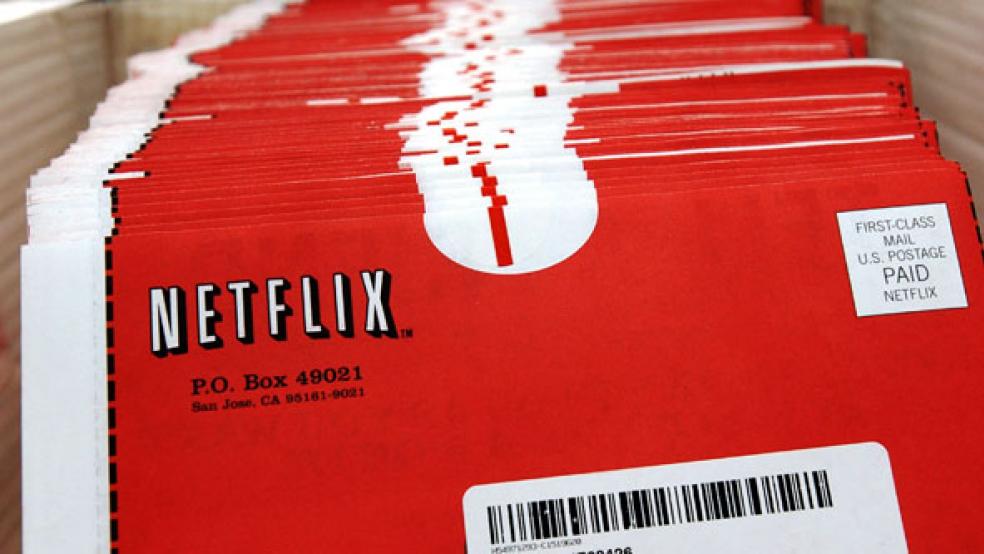Not all earnings surprises are created equal.
Better-than-expected earnings reports have been contributing to stock price gains for much of the last two weeks. And then there’s Netflix (NFLX), which on Monday reported a much narrower loss than Wall Street analysts had forecast, in spite of first-quarter revenue – $870 million – that was right in line with what investors had been told to expect. As soon as the results hit the wire, however, traders and investors scrambled to dump their holdings in the online media company as if it had suddenly become toxic. Within minutes, Netflix’s stock had plunged 14 percent in after-hours trading to around $88 a share, where they remain this morning.
Why wouldn’t investors want to celebrate Netflix’s “beat”? After all, the company has also made progress in getting its customers to download content on a host of mobile devices, from tablets to iPhones. And its international expansion – into Canada, Mexico and the U.K., among other destinations, is going well.
But those successes simply aren’t enough to offset the company’s first quarterly loss in seven years – not with questions about the company’s future subscriber growth and profits getting louder quarter by quarter.
When it launched, in the days of the first dotcom boom, DVD players were still new; the business of mail-order rental DVDs was one of those “killer apps” developed in the first wave of Internet innovation. But then came web 2.0, and an entirely new landscape. Suddenly, it wasn’t about getting physical DVDs into the hands of consumers, but about convincing them to fork over a monthly subscription to stream content onto a range of digital devices. Not only had the delivery mechanism for content changed, but so had the competitive landscape. Providers ranging from behemoths like Amazon (AMZN) to upstarts like Hulu.com all began offering similar content; Netflix was no longer dominant.
True, the company is adapting. At the end of the first quarter, it had 23.41 million subscribers paying a flat fee to download content from the “cloud,” up from 21.67 million at the end of the fourth quarter of 2011. But some analysts had hoped subscriber growth would be more robust; that Netflix would show more clearly that it is no longer as dependant as before on snail-mail home delivery of DVDs to drive profit margins.
Netflix still seems to be struggling to recover from its misstep of last year, when it briefly planned to separate and spin off the physical DVD rental business, forcing customers to set up two separate accounts and pay two separate subscription fees. Before the plan was announced, Netflix’s stock traded as high as $304 a share; its fall from grace since then has been rapid. When consumers rebelled and began seeking out alternatives, Netflix quickly retreated from the fray and went back to business as usual. But, CEO Reed Hastings admitted, the company is only six months into a three-year process of rebuilding trust and its reputation with actual and potential customers.
Staying in business and staying competitive isn’t going to be cheap. These days, Netflix has to battle for access to movies and shows – and sometimes it loses, as has happened with offerings from Sony (SNE) and Walt Disney (DIS). And it will need to continue expanding to meet consumer interest in streaming video in new markets, or risk losing those potential customers to rivals. That expansion won’t come cheap, either.
In the broader context, delivering a narrower-than-expected loss for a single three-month period is an underwhelming achievement. More important than today’s profits are signs that consumers – increasingly insatiable consumers of streamed content – are willing to sign up in droves for Netflix’s services. But Netflix no longer is a “must have” for cinephiles and TV junkies; it no longer has the reputation of being hyper-innovative, but rather of responding to technological change that it didn’t anticipate and that it can’t control.
When even the pros – the analysts on Wall Street who have been tracking this stock since its birth in the early days of the Internet – can’t figure out how it will manage to generate both growth in subscribers and higher profits, then it’s time to moderate expectations not just for the company’s earnings potential but also its share price. And that is just what happened in the aftermath of the earnings announcement, as investors looked past the immediate good news and into the future – and decided that they didn’t like what they saw.
Expect to see similar patterns take shape at other companies that have been market darlings of late, from yoga gear retailer Lululemon Athletica (LULU) to online retailer Amazon. Both command premium valuations; both face questions about how sustainable outsize earnings-growth rates have become.
In the wake of the stock market’s impressive gains over the last six or seven months, investors are hyper-aware that all it will take to trim 10 percent or 20 percent off the value of a stock is a shift in psychology. So they’ll be hyper-vigilant, and prepare to pull the trigger ahead of the rest of the market. In that kind of environment it makes sense to at least dig deeply looking for any vulnerability, decide ahead of time whether a favorite high-flyer would still look appealing priced 20 percent below current levels – and if the answer is no, maybe it’s time to head for the exits before the panicky stampede begins.






